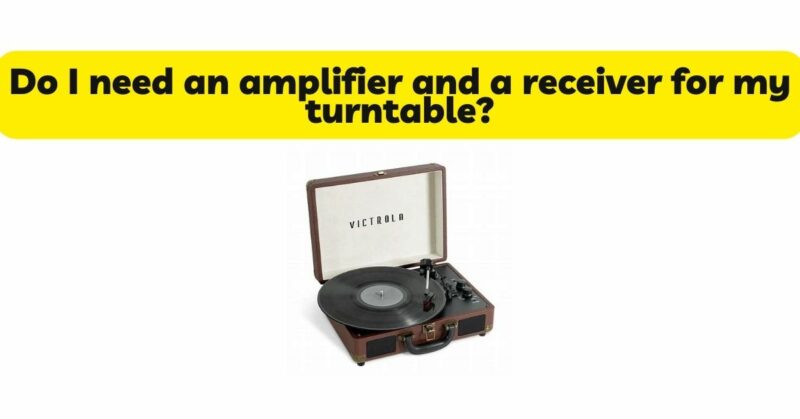Setting up a turntable audio system can be an exciting endeavor for music enthusiasts. However, questions often arise about the necessity of both an amplifier and a receiver in the setup. In this article, we will explore the roles of amplifiers and receivers in turntable systems and provide insights into whether both are required for an optimal listening experience. By understanding the functions of these components, considering different setups, and evaluating individual preferences, we aim to provide clarity on the need for an amplifier and receiver in your turntable audio system.
Understanding Amplifiers and Receivers: Before delving into the necessity of each component, it is essential to understand the differences between amplifiers and receivers. An amplifier is responsible for amplifying the audio signal from the turntable and powering the speakers. Its primary function is to increase the signal strength to a level suitable for audible playback. On the other hand, a receiver combines an amplifier with additional features, such as AM/FM radio tuners, input switching capabilities, and connectivity options for various audio sources.
The Role of Amplifiers in Turntable Systems: Amplifiers play a crucial role in turntable systems by amplifying the low-level signal produced by the turntable’s cartridge. This amplified signal is then sent to the speakers to produce sound. In setups where the turntable has a built-in phono preamp (phono stage), the signal can be directly connected to an amplifier. However, in setups without a built-in phono preamp, an external phono preamp is necessary to properly amplify and equalize the signal before connecting it to the amplifier.
Understanding Receivers and their Benefits: While amplifiers are dedicated to amplifying the audio signal, receivers offer additional features that enhance the functionality of your turntable system. Receivers typically include an amplifier, but they also incorporate AM/FM radio tuners, input switching capabilities, and sometimes even networking or Bluetooth connectivity options. If you desire the convenience of having these features in your audio system, a receiver can be a valuable addition.
Different Setup Options: The need for both an amplifier and a receiver in your turntable system depends on your specific requirements and preferences. Let’s explore a few common setup scenarios:
a. Turntable with Built-in Phono Preamp: If your turntable has a built-in phono preamp, you can connect it directly to either an amplifier or a receiver. In this case, the amplifier or receiver solely serves the purpose of powering the speakers and does not require a separate phono preamp.
b. Turntable without Built-in Phono Preamp: If your turntable does not have a built-in phono preamp, you will need an external phono preamp to amplify and equalize the signal before connecting it to either an amplifier or a receiver. In this scenario, you have the flexibility to choose between an amplifier or a receiver, depending on your desired features and connectivity options.
c. Customized System with Separate Components: For those seeking a more customizable setup, using separate components offers the flexibility to choose a dedicated phono preamp, amplifier, and additional features based on individual preferences. This configuration allows for a tailored system that can be expanded or upgraded in the future.
Considerations for Sound Quality: When considering the need for an amplifier and a receiver, sound quality is an important factor to consider. High-quality amplifiers and receivers can contribute to better audio reproduction, providing cleaner amplification and improved signal processing. However, it is worth noting that the specific components chosen, including the turntable, speakers, and the quality of recordings, also impact the overall sound quality.
Personal Preferences and Expandability: The need for an amplifier and a receiver ultimately depends on personal preferences and expandability plans. If you desire a simplified setup without additional features, an amplifier may suffice. However, if you value convenience, additional connectivity options, and future expandability, a receiver may be a better choice.
Conclusion: Determining whether you need both an amplifier and a receiver for your turntable system depends on various factors, including the presence of a built-in phono preamp, desired features, and personal preferences. Amplifiers play a crucial role in amplifying the audio signal, while receivers offer additional features and connectivity options. By evaluating your setup requirements, considering sound quality, and understanding your desired system functionality, you can make an informed decision on whether an amplifier, a receiver, or a combination of both is necessary for your turntable audio system.


